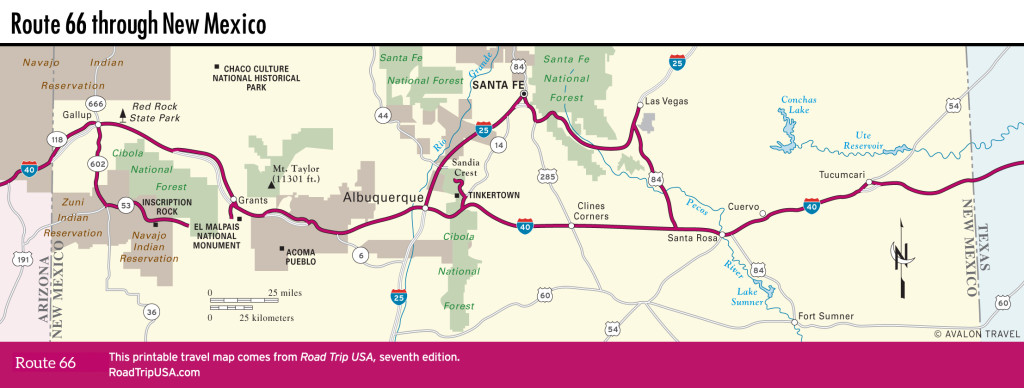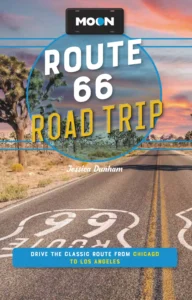Santa Fe
An hour away from Albuquerque via I-25 or its old road equivalents, Santa Fe (pop. 84,612) is one of the prime vacation destinations in the country. New Mexico’s state capital has been at the center of Southwestern life for centuries, and the cultural crossroads of a region that has been settled for thousands of years. From the east, detour north from Clines Corners via US-285, or for the full “Historic Route 66” tour, follow US-84 north near Santa Rosa toward Las Vegas (the original one, here in New Mexico), then continue west on I-25, parallel to the pioneer-era Santa Fe Trail.
Despite its swirling hordes of vacationers, and its vast infrastructure of hotels, restaurants, art galleries, and souvenir shops, Santa Fe remains one of the most enjoyably un-American small cities. It makes the most sense to begin your tour of Santa Fe at its center, the Plaza. This will help you get not only your geographical bearings but also a historical context with which to appreciate the rest of Santa Fe. On the north side of the Plaza, the Palace of the Governors (105 W. Palace Ave., daily May-Oct., Tues.-Sun. Nov.-Apr., $12) is the oldest continuously used public building in America. Dating from 1610, the palace served as residence for Spanish, Mexican, and, later, American territorial governors until 1909, when the New Mexico legislature voted to turn the building into the Museum of New Mexico (it’s now the New Mexico History Museum’s largest artifact). The museum contains an excellent overview of the building’s and the city’s tumultuous history, numerous artifacts and documents, and an exhaustive collection of regional photographs.
To get a sense of the life and work of the woman who did as much as anyone to fix Santa Fe in the American mind, walk two blocks west and one block north from the Plaza to the Georgia O’Keeffe Museum (217 Johnson St., 505/946-1000, daily, $13), with a collection of 1,149 pieces of the late artist’s work. Many of the paintings depict the landscape in and around her home at Abiquiú, north of Santa Fe, where she lived for 40 years.
Shops, shops, and more shops (plus a few cafés and restaurants) line the streets emanating from the Plaza. Many of these have a decidedly upscale bent; there are about 300 art galleries alone in Santa Fe, for instance (though the most engaging and scenic stretch of them is found along narrow and tree-lined Canyon Road, which runs east from Paseo de Peralta up into the foothills above town). Once you penetrate Santa Fe’s Paseo de Peralta, the historic ring road encircling the 17th-century city center, leave your car at one of the many parking lots or garages and see Santa Fe on foot. Another downtown street, Old Pecos Trail, carried Route 66 for its first dozen years before Santa Fe was bypassed in favor of Albuquerque in 1937.
If you’re interested in classical music, the Santa Fe Chamber Music Festival (505/982-1890 or 888/221-9836) performances take place June to August in a variety of atmospheric old Santa Fe buildings.
Where to Eat and Stay in Santa Fe
It’s a pleasant surprise that only moderately deep pockets are needed to find good food or memorable accommodations in Santa Fe. With recipes that show the influence of more than 2,000 years of Native American culture (which contributed three major staples: beans, corn, and squash), some 400 years of Roman Catholic inclusion (chilies, cilantro, cumin, onions, garlic, wheat, rice, and both beef and pork), and a liberal dash of American inventiveness, Santa Fe restaurants serve the world’s oldest, newest, and, some say, tastiest cuisines—often all side by side on the same plates. Menu offerings include dishes like a buttermilk corn cake with smoky chipotle-chili shrimp (and a side of red-chili onion rings), chiles rellenos stuffed with roast duck and black bean mole sauce, or blue corn turkey enchiladas. Santa Fe’s fine food is at least as much a draw as its rich history and magical mountain light.
To ease your way into Santa Fe food, start on the Plaza at the Plaza Café (54 Lincoln Ave., 505/982-1664), which has been serving no-nonsense meals since it opened in 1905. Part of the fun here is the constant clatter of dishes and silverware, the old-fashioned tile floor, and a rear wall with a giant map of the Southwest. If you don’t have time for a full meal (the green-chili meatloaf is a specialty), pop in for a helping of Frito pie, which is quite the local delicacy (although the recipe allegedly originated in Texas in the 1930s, when Daisy Doolin, the mother of the Dallas
Just off the Plaza, and well worth a visit for its addictive breakfast quesadilla (with scrambled eggs, applewood-smoked bacon, Jack cheese, and guacamole), is Café Pasqual’s (121 Don Gaspar Ave ., 505/983-9340), which has deliciously inventive dishes at lunch and dinner, too. After a meal elsewhere (unless someone else is paying your expenses!), join Santa Fe’s old guard at the Pink Adobe (406 Old Santa Fe Trail, 505/983- 7712), also known as simply “The Pink,” a deluxe retro-minded supper club that’s also home to the kitschy Dragon Room bar, a popular late-night hangout.
For a convenient and memorable place to stay, a pair of small B&B gems are within a short walk of the Plaza. Adobe Abode (202 Chapelle St., 505/983-3133, $125 and up), as the name suggests, consists of several large adobe-style rooms and casitas.
If you prefer to park within sight of your room, there’s a nice motor inn with a location that’s hard to beat: Garrett’s Desert Inn (311 Old Santa Fe Trail, 505/982-1851, $79 and up), a few blocks off the Plaza. If all the desirable places are full, or if you’re tight on funds, cruise along busy Cerrillos Road (Hwy-14), where you’ll find all the major chains.
Travel Map of New Mexico

















